
RSK® Mk5 (Second Generation) Fixed Blade Survival Kit Knife
 | Doug Ritter RSK® Mk5 (Second Generation) Fixed Blade Survival Kit Knife |
"Are you sure you need this (RSK® Mk5 prototype) back?"
RSK® Mk5 field tester during development
Knife Rights Chairman Doug Ritter's compact RSKŪ Mk5 fixed blade is once again available. The second generation of the RSKŪ Mk5 is being manufactured by the same factory in China as manufactured the original. Discontinued by CRKT a number of years ago, Blue Ridge Knives, the world's largest knife distributor, has stepped up to make this popular knife available again though knife retailers nationwide with an MSRP of just $15.95.
The RSKŪ Mk5 is a petite, lightweight fixed blade designed to some very strict constraints. As such, it really isn't meant to be an EDC (Every Day Carry) blade, though many have used it as one. It was designed expressly as a back-up blade, and specifically to fit into a small survival kit tin or pouch. The RSKŪ Mk5 is compact and light enough to fit in almost any small personal survival kit or stash-away location, yet robust enough that it's still a knife you can bet your life on.
NOTE: "Mk" is pronounced "Mark," so RSK Mark Five
Income from the sale of the RSKŪ Mk5-G2 and my other RSKŪ knives and gear allow me to spend the majority of my time on Knife Rights' efforts to free knife owners from irrational knife restrictions. This has resulted in 33 bills enacted repealing knife bans in 23 states and over 100 cities and towns, eight anti-knife bills defeated and numerous litigation victories since 2010.
The RSKŪ Mk5 was the result of a collaboration between me, knifemaker David White, and Dr. Andrew Osborne. Click here to read about the genesis of this knife, as originally produced by CRKT.
The key criteria for this knife were that it had to fit in an Altoids tin, it had to be lightweight, it had to be robust enough to stand up to the type of abuse that can occur in a survival situation, it had to be functional and reasonably comfortable to use and it had to be inexpensive while at the same time providing a reasonable level of quality and reliability.
RSKŪ Mk5 Specifications* | |
| Blade Material | 3Cr13 hardened to 52-55 HRC |
| Blade Length | 1.75 in. (44.5 mm) |
| Edge Length | 1.94 in. (49.3 mm) plain edge |
| Blade Thickness | 0.12 in. (3 mm) |
| Blade Shape | Wide-Chord Drop Point |
| Blade Grind | High Flat Grind |
| Overall Length | 3.80 in. (97 mm) |
| Handle | Skeletonized Tang |
| Weight | 0.78 oz. (22 g) |
| Sheath | Molded & Riveted Glass-Reinforced Nylon |
| Weight w/ Sheath | 0.88 oz. (25 g) |
| *Specifications subject to change without notice. All dimensions and weights are nominal. | |
The RSKŪ Mk5's wide chord drop point 1.75-inch (44.5 mm) blade provides a nearly 2-inch edge (1.94 inches (49.3 mm) to be exact). Overall length is 3.80 inches (97 mm).
It is made from the same 3Cr13 stainless steel as before, hardened to 52-55 HRC. That's comparable to "420-MOD" or 420-Modified" in U.S. nomenclature. It's got just enough carbon (0.30% - 0.35%) to have acceptable edge holding and the relatively high nickel (0.5%) adds toughness. Many manufacturers of quality budget knives have used it extensively with good results.
In terms of edge retention, in my testing and that of associates, it performed adequately for typical survival chores such as making feather sticks, splitting wood, constructing shelter, etc. While the edge may roll when abused, we saw no chipping and it is very easy to sharpen, even just using a found stone. While higher carbon steel would have been nice for the improved edge retention it would offer, it would have increased the cost. I can live with this for the design point, a short term survival incident. It was certainly one of the key compromises we needed to make to keep the price in bounds.
One side benefit of the 3Cr13 steel is that is has pretty high resistance to corrosion, which is an advantage in a knife that may be stored away for years before it is ever used. It is available in both a stonewashed and a black-coated finish (model DRMK5 and DRMK5K, respectively).
The ergonomic curved handle provides a secure and comfortable two-finger grip for most users. The para-cord lanyard attached to the RSKŪ Mk5 is an integral part of the design. It helps provide a more secure and comfortable grip by effectively lengthening the short handle without adding hardly anything in the way of bulk or weight.
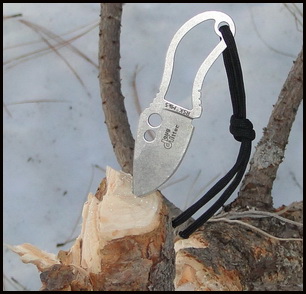 You should adjust the position of the knot so that when you grasp the knife and lanyard, the knot fits snugly into the end of your fist. You can cut off excess cord if desired (remember to melt the ends).
You should adjust the position of the knot so that when you grasp the knife and lanyard, the knot fits snugly into the end of your fist. You can cut off excess cord if desired (remember to melt the ends).
The knot also serves to keep your fingers safe, by helping to lock the handle in your grip. Combined with the agressive jimping (slots) on the underside of the handle to retain your index finger and the jumped thumb rest, they help prevent your finger from slipping forward onto the blade's edge. The two holes in the blade, besides lightening it some, provide a bit of extra purchase if you use a pinch grip.
The skelitonized handle can be wrapped in paracord if desired.
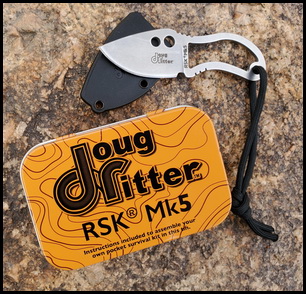 I and my testers have used this diminutive blade to perform all the normal survival chores you'd expect to need to do with a knife. We made feather sticks, cut down saplings for shelter, cut branches and sharpened the ends, dressed game, cleaned fish, and generally used and abused the RSKŪ Mk5 just like you might have to if you were depending upon it to save your life.
I and my testers have used this diminutive blade to perform all the normal survival chores you'd expect to need to do with a knife. We made feather sticks, cut down saplings for shelter, cut branches and sharpened the ends, dressed game, cleaned fish, and generally used and abused the RSKŪ Mk5 just like you might have to if you were depending upon it to save your life.
The choil at the base of the blade makes a good scraper if using a ferrocerium rod to light a fire. It works best with 1/4-inch or 3/8-inch rods.
The blade is laser engraved on the front with my Doug Ritter trademark, and on the tang, "RSKŪ Mk5." The BRK model number is laser engraved on the reverse.
The riveted glass-reinforced Nylon (GRN) sheath weighs in at just a hair over one-tenth of an ounce. The sheath has a hollow rivet at the tip sized for the standard 3/32" or 2.4mm (#3) ball chain used for dog tags and such. If you remove the inner strands, you can use para-cord outer sheathing. Or, use a split ring for a perfectly flat carry. For a short-term survival situation, it can be carried in a pocket, hung from your belt or hung on a safety lanyard or chain around your neck.
You don't need to jerk the knife free of the sheath, as is the case with many neck knives. The angle cut into the sheath opening at the top is there to allow you to use your thumb to push against the sheath to withdraw the knife, so it can be worn with a safety lanyard without impacting function.
The RSKŪ Mk5-G2 comes packed in a custom bright orange Survival Preparedness Tin, the same size as an Altoids tin. Included is an instruction sheet titled, "BUILDING YOUR POCKET SURVIVAL TIN AROUND THE RSKŪ Mk5" which I authored (click here to download a copy). The sheet provides a list of components that could be used to assemble your own Pocket Survival Tin using the RSKŪ Mk5 tin.
MSRP for the RSKŪ Mk5-G2 is $15.95, available at many knife retailers nationwide. Limited lifetime warranty from Blue Ridge Knives.
Proceeds from the sale of Doug Ritter Gear supports Knife Rights' efforts to free knife owners from irrational knife restrictions.
| ||||||
| Doug Ritter RSKŪ Mk5-G2 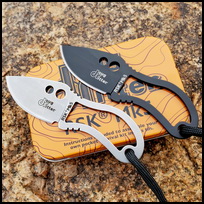 |
|
Doug Ritter RSKŪ Mk3-G2 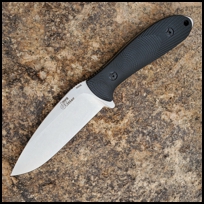 |
|
Doug Ritter Mini-RSKŪ Mk1-G2 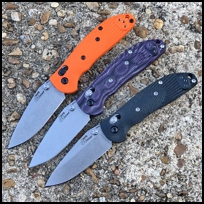 |
|
Doug Ritter RSKŪ Mk1-G2 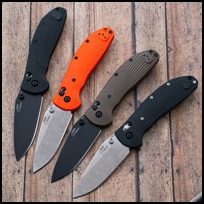 |
|
Email Doug Ritter
URL:
http://www.DougRitter.com/rsk_mk5-g2.htm
First Published: February 8, 2021
|